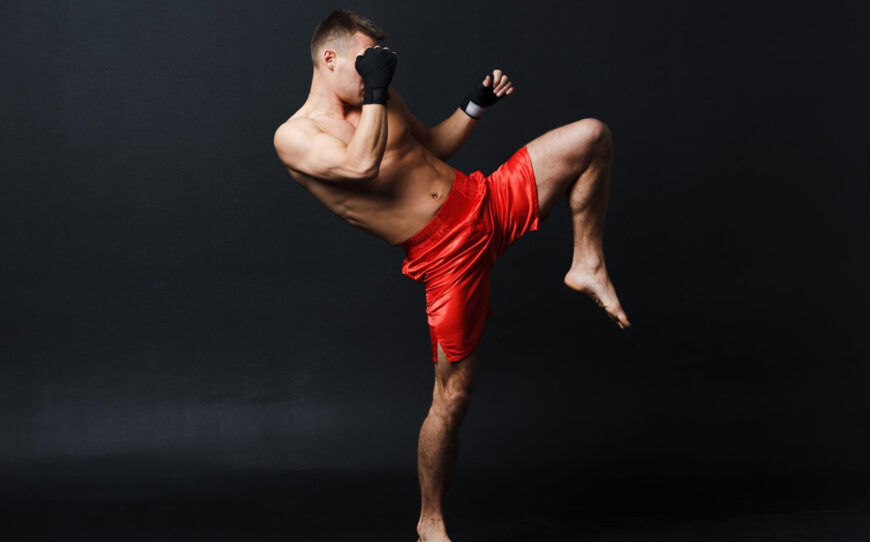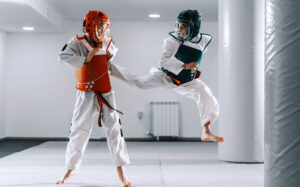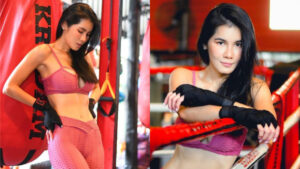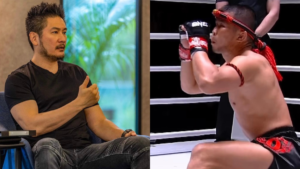Muay Thai is an ancient martial art from Thailand. It is a captivating and highly effective combat sport that demands precision, agility, and power. One of the most critical aspects of this enthralling discipline is mastering various Muay Thai stances. It is key to optimizing fighting techniques and strategies in both offensive and defensive situations.
This informative blog post delves into the fundamentals of traditional and modified stances. Here are a few tips for perfecting your stance through diligent practice.
Key Takeaways
- Proper stance is critical to generate power and maintain stability and balance in Muay Thai.
- Traditional Thai and modified stances cater to different fighter styles and preferences. Each has its strategic advantages and challenges against various opponents.
- Mastering basic Muay Thai stance involves proper foot placement and weight distribution. Hand positioning, guard usage, and maintaining a stable posture with relaxed hips are others.
- Advanced Muay Thai stances include the L stance for powerful kicks or the Side Stance for evasive maneuvers. They require patience, practice, and dedication for mastery.
The Importance of Proper Stance In Muay Thai
Proper stance is critical in Muay Thai to generate power and maintain stability and balance while enabling efficient movement.
Understanding The Fundamentals Of Muay Thai Stance
Muay Thai is a powerful and dynamic martial art. It has gained immense popularity among MMA enthusiasts worldwide. At the heart of its effectiveness lies an ancient wisdom. It revolves around the fundamental importance of having a proper fighting stance.
A well-structured Muay Thai stance maximizes stability and allows for seamless transitions between offensive and defensive maneuvers. The ancient Siamese combat system emphasizes creating triangular structures within the body. It is done to generate power and maintain balance throughout various movements.
Furthermore, adopting an effective guard position with hands up high is also critical. It ensures that fighters are always ready to launch deadly counterattacks without being vulnerable to opponent strikes.
Traditional Thai Stances Vs. Modified Stances
Traditional and modified Thai stances play a significant role in the diverse world of Muay Thai. They cater to different fighters’ styles and preferences.
Traditional Thai stances emphasize stability and power generation by structuring the fighter’s body around triangles. It results in an upright posture with feet slightly wider apart and hands held high.
Besides, modified Muay Thai stances have emerged as fighters adapt their techniques to suit their strengths or counter specific opponents.
Some competitors may choose a more square stance similar to Western boxing. It allows quicker footwork techniques while sacrificing some defensive protection against leg strikes.
Other adaptations include adopting elements from Kickboxing or Karate into one’s Muay Thai repertoire. It creates unique fighting strategies tailored specifically for MMA competitions or personal preferences.
Common Stances Used In Muay Thai
Muay Thai fighters utilize various stances to engage their opponents strategically, adapt to different fighting styles, and master the martial art. Some of the most common Muay Thai stances include:
- Basic Muay Thai Stance: This foundational stance perfectly balances offense and defense. It focuses on proper foot placement, hand positioning, and body posture for maximum stability and power.
- Orthodox Stance: Suitable for right-handed athletes, this stance has the left foot forward and the right foot back. The latter is slightly rotated outwards to support effective strikes and defensive maneuvers.
- Southpaw Stance: The mirror image of the orthodox stance is ideal for left-handed athletes. They place their right foot forward and use their dominant hand in a leading position for powerful strikes.
- L Stance: It is a more defensive posture. This stance enables fighters to minimize their target profile while maximizing their ability to dodge incoming attacks.
- Side Stance: Also known as a bladed stance, this posture presents an even narrower target profile. It keeps the body sideways toward the opponent, emphasizing quick lateral movement and evasive tactics.
- Long Stance: It focuses on maintaining distance from an opponent while delivering powerful kicks and strikes using range advantage. This stance involves having one leg extended further back than in other stances.
- Switch Stance: Skilled fighters use an advanced technique to change between orthodox and southpaw stances rapidly. It confuses opponents or creates new offensive/defensive opportunities based on specific situations in a fight.
Each of these stances provides strategic advantages in particular circumstances against different styles or techniques in Muay Thai competition. Mastering multiple stances improves a fighter’s overall skillset. It increases their adaptability and effectiveness during intense martial arts bouts in the ring or on the mat.
Mastering Basic Muay Thai Stance
To master the basic Muay Thai stance, one must focus on a few things. They include proper foot placement and weight distribution, hand positioning and guard, and a stable posture with relaxed hips.
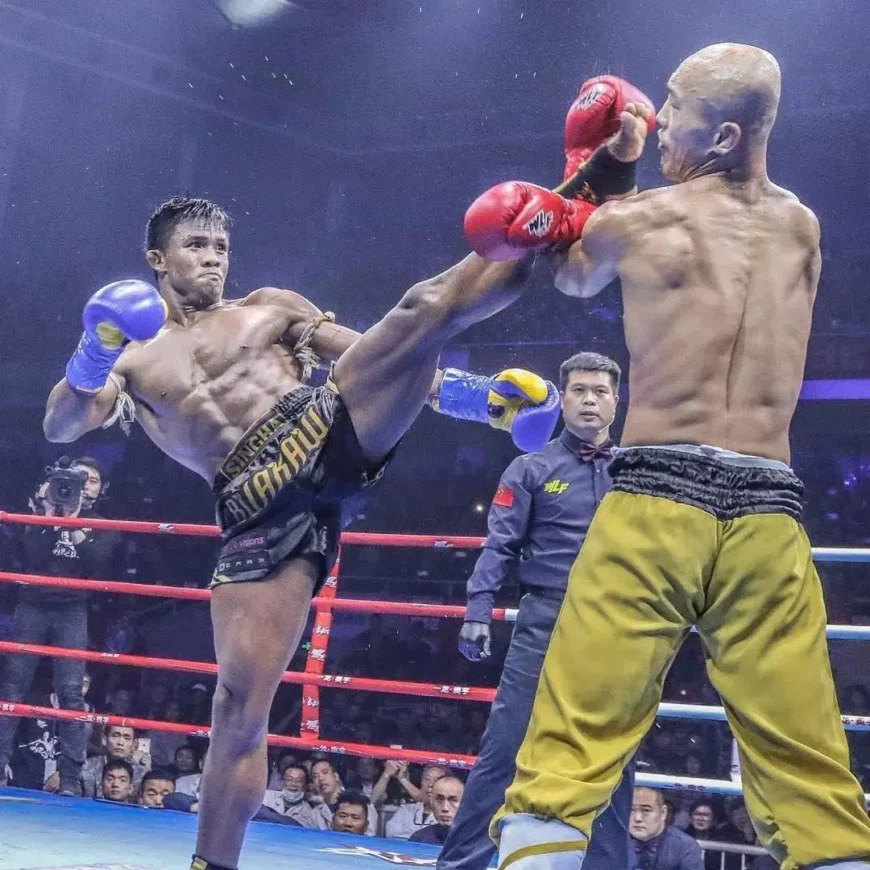
Foot Placement And Weight Distribution
Proper foot placement and weight distribution are key to a correct Muay Thai stance. In Muay Thai, fighters keep their feet shoulder-width apart. One foot (usually the dominant) is placed slightly forward to provide balance and facilitate movement.
To generate power in strikes, proper weight transfer is crucial. A fighter must shift their body’s weight from one leg to another during attacks while maintaining stability through the core.
Mastering these elements lays a foundation for advanced techniques like throws and kickboxing combinations.
Hand Positioning And Guard
Proper hand positioning and guarding are crucial aspects of the Muay Thai stance. In Muay Thai, the hands are used for both offense and defense. This makes it essential to keep them in the right position.
The fighter’s hands should be held at about cheek level with elbows tucked close to their sides. The guard is used for protection against incoming strikes from the opponent.
There are two essential guards in Muay Thai: high and low. The high guard involves having both arms up close to cover the head and upper body while keeping elbows close together. It provides maximum protection against head kicks or punches.
You can defend yourself effectively from offensive strikes by mastering proper hand positioning and maintaining a good defensive posture. Setting yourself up for quick counters that can take down an opponent swiftly becomes possible.
Hips And Body Posture
Proper hip and body posture is essential to mastering the Muay Thai stance. In this martial art, fighters must have a strong base and keep their center of gravity low for balance.
The hips are crucial in generating power while striking, making it important to position them correctly. The ideal hip posture involves keeping them squared off so they’re not unnecessarily turned or twisted.
Proper hip and body posture also helps with defense in Muay Thai. Keeping your hips square makes it harder for your opponent to take you down or sweep your legs from under you.
Advanced Muay Thai Stances
Advanced Muay Thai stances include the L stance. It is used for quick direction changes and to lure opponents into range. The side stance emphasizes mobility and evasive maneuvers, maximizing reach and power in kicks. Finally, the switch stance is a transitional position between orthodox and southpaw that can throw off an opponent’s timing.
The L Stance
The L stance is a versatile Muay Thai stance that can be used for offensive and defensive purposes. It involves stepping forward with one leg while keeping the other back in a traditional fighting stance. It creates an “L” shape.
This stance is ideal for evading attacks while simultaneously setting up counterattacks.
Many fighters prefer using the L stance to set up powerful kicks. It allows them to generate more power and maintain better balance during the execution of the kick.
One popular technique that utilizes this approach is the low roundhouse kick. It targets an opponent’s thigh or calf with a swift, powerful strike.
Martial artists can keep their opponents off-balance by utilizing different stances like the L stance. This makes scoring points easier or taking control of a fight.
The Side Stance
The Side Stance is a defensive Muay Thai stance that protects against incoming strikes while providing counter-attack opportunities.
This stance involves stepping out with one leg, keeping the other foot in place, and turning it slightly outward. The lead hand is extended forward, palm facing down, while the rear hand covers the chin.
A skilled fighter can use this stance to dodge punches by slipping or ducking under them. They can deliver powerful counters with their fists or knees. With proper training and practice, fighters can shift quickly between stances depending on whether they are attacking or defending.
The Long Stance
The Long Stance is a widely used Muay Thai stance emphasizing range and power. It’s an attacking stance to keep the fighter at bay while generating powerful kicks and punches.
In this stance, the lead leg is positioned farther back than usual. It provides stability and allows quick movement forward or backward when needed. The rear foot is angled outwards for better mobility, enabling powerful step-through techniques.
Fighters who excel at long-range fighting often prefer this type of stance due to its ability to deliver devastating strikes from afar.
The Switch Stance
One of the more advanced stances in Muay Thai is the switch stance. This involves quickly switching your lead foot. You can change from an orthodox to a southpaw stance or vice versa.
An effective switch stance requires excellent footwork and timing. The fighters must correctly time the switch to protect themselves while transitioning into their new position.
Mastering the switch stance takes practice and patience. But it can add a new dimension to any fighter’s strategies in Muay Thai combat.
Benefits Of Proper Muay Thai Stance
Proper Muay Thai stances improve balance and stability, increase power and speed, and enhance defensive techniques.
Improved Balance And Stability
Maintaining a proper Muay Thai stance on the mat can be challenging, but it has many benefits for fighters. Improving balance and stability is just one of these advantages. With a solid base, fighters can deliver powerful strikes while remaining rooted to the ground.
An athlete must focus on foot placement and weight distribution to achieve better balance and stability in Muay Thai. The fighter’s base should be wide enough to maintain its center of gravity despite incoming punches.
They should avoid leaning forward or back too much. This prevents losing control which could lead to being taken down by an opponent.
Improving balance through training will make all aspects of fighting more effective. It enables jabs, hooks, and kicks to be delivered faster and more accurately. This enhances performance in combat sports like kickboxing or mixed martial arts (MMA).
Increased Power And Speed
A proper Muay Thai stance is crucial for generating maximum power and speed in strikes. By planting the foot strongly and distributing weight efficiently, fighters can transfer energy from their legs and hips. This results in devastating punches, kicks, elbows, and knees.
Besides increased offensive capabilities, a solid Muay Thai stance enables quick movements and enhanced defensive techniques. The balanced posture provides stability while moving forward, backward, or sideward during combat.
Fighters with excellent footwork can swiftly move out of range from an opponent’s attacks or launch counterattacks effectively.
Enhanced Defensive Techniques
Proper Muay Thai stance can significantly enhance defensive techniques in the sport. It becomes easier to evade incoming strikes while keeping balance with a correct fighting posture.
A good stance allows for quicker footwork and better movement. It is beneficial when countering attacks or slipping punches.
A well-executed Muay Thai guard position enhances defense by protecting against strikes and blocking kicks. Proper hand positioning is essential. Raising your elbows too high leaves openings for punches to land on the sides of your face or body.
Tips For Practicing And Perfecting Your Muay Thai Stance
To perfect your Muay Thai stance, keep a balanced and relaxed posture. Incorporate stance drills into your training routine and adjust your stance for optimal performance. Focus on developing strong footwork techniques.
Whether you’re new to the sport or looking to take your skills to the next level, these tips can help. Use them to optimize your fighting technique and enhance your overall performance.
Keeping A Balanced And Relaxed Stance
Maintaining a balanced and relaxed stance is critical in Muay Thai. A fighter’s stance should be loose enough to allow quick movements and evasions but stable enough to generate power.
But keeping a balanced and relaxed stance takes practice, focus, and discipline. Stance drills are essential to training as they help fighters develop muscle memory. This helps maintain proper positioning throughout a match.
Regularly adjusting one’s stance according to one’s opponent’s moves maximizes effectiveness.
Incorporating Stance Drills Into Your Training
To master your Muay Thai stance, you must regularly incorporate specific drills into your training routine. Here are some tips for effective stance drills:
- Shadowboxing: Shadowboxing is essential to any martial arts training regime. It’s beneficial for practicing and perfecting your stance. During shadowboxing, focus on maintaining the correct foot placement, body posture, hip movement, and guard.
- Mirror Drills: Set up a mirror during training sessions to observe yourself as you practice different stances and techniques. Watch closely for any mistakes or weaknesses in your posture and make necessary adjustments.
- Resistance Training: Resistance training is critical for building strength and endurance in the legs, hips, back, and shoulders. It is vital for achieving optimal fighting stances.
- Weight Distribution Exercises: Incorporate exercises that help improve weight distribution across both feet during strikes or defensive maneuvers. One example includes standing on one leg while the other is bent at the knee. Lean slightly until you feel the tension in your quads before returning to an upright position.
- Footwork Drills: Adding footwork drills like pivots and shuffling will help train you to move quickly while maintaining balance under different scenarios.
Incorporating these drills into your regular Muay Thai training routine lets you perfect your fighting stance. Use them to optimize every strike or defense move during competition or sparring sessions.
Regularly Adjusting Your Stance For Optimal Performance
One must regularly adjust their stance to achieve optimal performance in Muay Thai. Effective movement and strikes require a balance between offensive and defensive techniques. It can only be achieved by adjusting the fighter’s position to suit the situation.
When defending against an opponent’s attack, a Muay Thai fighter may shift their weight backward to avoid taking the hit directly.
Adjusting your stance also involves making small changes to improve your fighting style. For instance, slightly lower your center of gravity. Doing it as you adopt a particular stance can help build momentum for kicks and punches.
Some stances are better suited for attacking than defending (and vice versa). Modify them to suit your specific needs in a fight.
Importance Of Footwork In Muay Thai
In Muay Thai, footwork is just as important as the proper stance. It allows fighters to move around the ring, evade attacks, and set up strikes effectively. Good footwork enables a fighter to maintain balance while throwing punches, kicks, knees, or elbows.
Proper footwork also plays a critical role in defensive maneuvers. Footwork allows fighters to keep their distance from their opponent. It also helps take small steps rather than long strides that could leave them off-balance and vulnerable to counterattacks.
FAQs
1. What Are The Different Muay Thai Stances?
Muay Thai stances include orthodox (right-handed) and southpaw (left-handed). There are a variety of guard positions, like the high, low, and defensive stances.
2. Does My Stance Affect My Performance In Muay Thai?
Your stance can significantly affect your performance in Muay Thai. It determines your position for strikes and defense against your opponent’s attacks. The proper stance can help improve balance, power, agility, and overall effectiveness in the ring.
3. How Do I Determine Which Muay Thai Stance Is Best For Me?
The choice of a Muay Thai stance largely depends on your dominant hand or foot position. Factors like height or reach also play a role. Training with orthodox and southpaw stances helps develop versatility and adaptability during fights.
4. Can I Switch Between Stances During A Fight?
Switching between stances can be an effective strategy when done correctly. It confuses opponents by changing striking angles while maintaining balance throughout moves and counters.
It requires significant training/practice so that these transitions/switches become second nature rather than slowing down movements. Regular training eliminates thinking through each transition process step every time a change is made.
Conclusion
Mastering the Muay Thai stance is essential for any athlete looking to excel in this ancient Siamese martial art. From foot placement and weight distribution to hand positioning and guard, understanding the fundamentals of the sport’s stances can make all the difference.
Whether practicing basic or advanced techniques, incorporate stance drills into your training regimen. Adjusting your stance for optimal results and proper posture is critical in Muay Thai fighting styles.
With enhanced balance and stability, increased power and speed, and advanced defensive maneuvers – perfecting the right posture will help you become a dominant fighter.

